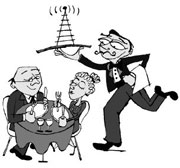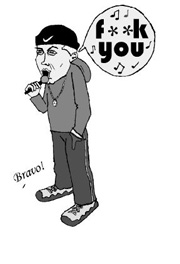PUBLIC RADIO HAS money. Lots of it. It’s a big business these days—a business worth supporting, but still a useful fact to keep in mind during the next pledge drive.
The business end of public radio was in full bloom last week at the annual Public Radio Conference, a national gathering of public radio execs that happened, this year, to be held at the Washington State Convention and Trade Center. The 900-person gathering, almost entirely composed of management types, had all the familiar markings of the bigger NAB (National Association of Broadcasters) trade shows of its commercial siblings: “branded” personalities (yes, they use that language) hosting live remotes and pricey social events, panels and keynotes on the Future of the Industry, and exhibit halls filled with program syndicators and tech suppliers. The only difference from a Vegas NAB gathering was the absence of station owners. For public radio, that would be you and me—and, at $500 a pop for registration, we weren’t there. In 30 years, public radio has grown from a poor stepchild into a media force.
It has also strayed quite a bit from the original mission envisioned by the document that spawned it, the 1967Carnegie Commission report, and, in doing so, it’s painted itself into a corner. Public radio wasn’t intended to become a $500 per invitation affair; it wasn’t meant to be concerned with audience demographics and psychographics and platforms and segment-based marketing and user-created content and shared environments and all the other crass, commercial buzzwords in evidence last week. It was meant to be radio for the rest of us—an accessible media guaranteeing that, beyond the pop culture vulgarity of commercial radio, there would be outlets for diverse viewpoints, cultures, and communities that aren’t heard elsewhere. Public radio today does many valuable things, but, by and large, that’s not one of them. It’s radio for educated, upper-middle-class white professionals—and therein lies both its success and failure.
The Seattle gathering actually focused on that reality as part of its theme (“Expanding Our Reach,” which refers to both drawing new audiences and using new technologies). I happened to be there because, on the kind recommendation of folks from local host stations KUOW, 94.9 FM, and KPLU, 88.5 FM, I was asked to talk about Low Power FM (LPFM), the microradio initiative that National Public Radio effectively helped kill in the waning days of Congress last December. (A limited filing window is coming up for Washington state LPFM allocations on June 15-19, but it only applies to distant rural areas.) More specifically, I was asked to talk about the demand for LPFM, and who it was, exactly, that didn’t find public radio to be meeting their needs. Sharing the session were other breakout groups discussing Hispanics, African Americans, queers, youth, conservatives, and other groups marginalized in the public radio world.
REACH OUT, NOW!
How’d it go? Well, I worked in radio for years, so I had a great time; it was interesting, folks were friendly, I was comfortable. I’m an overeducated, middle-aged white professional; of course I was at home. But those of us in National Public Radio’s ballroom crowd didn’t look very representative of the national public. The demand for LPFM, and for all sorts of alternative media, comes from people not in these rooms—folks underserved (or completely unserved) by major media of all stripes, while our taxpayer-supported public radio and TV focus on an audience that’s frightfully overserved.
If it wanted to, public radio could, simply by tweaking its programming, reach out to many of those groups: It could increase local, and even neighborhood and small town-based, programming; it could increase cultural diversity, both in programming and personnel; it could forsake satellite-delivered fare for more local news, particularly in marginalized communities, and use sources other than the usual experts, politicians, academicians, and corporate spokespeople; it could increase other programming with diverse political sources and/or opinions (e.g., right and left wing; labor, not just business; specialized talk shows on senior or youth issues; etc.); it could, especially for music stations like KPLU, do the same things with music and the arts.
Discussions of such outreach tended to focus facilely on news content—that is, making sure that the privileged white folks listening are aware of the less visible communities in their midst. That’s a fine service, but it’s not diversity. Few public radio stations are taking the next steps: having actual programs that appeal to those communities, and including people from those communities among their personnel and, especially, in their decision-making.
At this point, public radio can certainly improve its diversity, but it is not likely to move backward; it won’t intentionally risk giving up its current loyal audience cash cow to also better serve less lucrative audiences. But it could fulfill its original mission in a different way: by diverting some of its resources, expertise, and, yes, money to support alternative media and community institutions that do directly serve—and are run by—marginalized groups. A KUOW, for example, is never going to broadcast a significant part of its programming in Spanish—but it could help, say, the farmworkers or El Centro de la Raza fill a similar function. The loss of Low Power FM in urban areas was an unfortunate foreclosing of one way that could have happened—but there are others. All that’s needed is for public radio to consider the rest of us.







